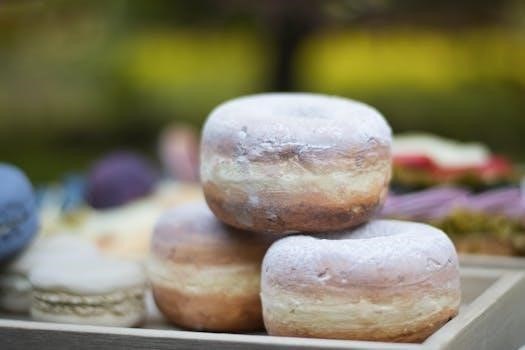
Glaze coats are used to enhance finishes‚ often applied after stain and sealer‚ but before topcoats. They add depth and can create antique looks. Glazes require careful application using a brush in small sections‚ followed by blending with a rag. Proper temperature is also important for best results.
Understanding Glaze Coats
Glaze coats represent a versatile technique in finishing‚ essentially functioning as a modified second layer of stain that enhances the visual characteristics of a project. Unlike a standard topcoat‚ which primarily serves to protect the surface‚ glazes are designed to add depth‚ highlight details‚ and introduce subtle color variations. They are typically applied after a sealer but prior to the final protective layers‚ allowing for manipulation and blending to achieve the desired effect. This process involves using a brush to apply the glaze‚ and then a rag to blend it‚ controlling its visual impact. Understanding how glazes interact with underlying finishes is crucial to achieve the desired result‚ as they may react differently depending on the surface and materials they are applied to. It’s important to also consider factors such as the drying time and mixing ratios to ensure a smooth and professional finish. The choice of glaze will significantly affect the final appearance‚ whether it’s a deep‚ dramatic effect or a soft‚ subtle enhancement.
Why Use a Glaze Coat?
Glaze coats are used to create effects that regular finishes cannot achieve. They help in accentuating intricate details on a surface‚ bringing out carvings and textures that might otherwise be lost. One of the main reasons to apply a glaze is to give a piece an aged or antique appearance. By settling into crevices and recessed areas‚ the glaze creates a shadowed effect‚ mimicking the natural wear and patina of time. Furthermore‚ glaze coats offer an opportunity to introduce subtle color shifts‚ allowing for customization. This process is especially useful when working with chalk paint‚ where the glaze adds depth and interest to the flat finish. Glazes add visual dimension and character. Additionally‚ they can be used to enhance faux finishes‚ offering a rich and layered look that elevates the overall aesthetics of a piece. Therefore‚ a glaze coat is not just a finish but a design element that can dramatically alter the look of an object.
Choosing the Right Glaze
Selecting the appropriate glaze is crucial for achieving the desired effect on your project. Glazes come in various colors and consistencies‚ each designed to produce a different outcome. For a dramatic‚ bold look‚ darker glazes like Smoky Quartz work best‚ providing a strong contrast and highlighting details; Conversely‚ if you’re aiming for a more subtle and softer appearance‚ lighter and more transparent glazes are ideal‚ blending gently with the base color. Consider the base color of your piece as well as the overall tone you wish to achieve. The type of glaze you choose will also depend on the application method you plan to use. Some glazes are better suited for brushing‚ while others are designed for ragging or sponging. Always test a small‚ inconspicuous area before applying the glaze to the entire surface. This step allows you to ensure that the glaze provides the desired look‚ and is compatible with your existing finish. Remember‚ the right glaze can transform the whole look of your furniture or project.

Preparing the Surface
Proper surface preparation is paramount before applying any glaze coat‚ and it significantly impacts the final result. Start by ensuring the surface is completely clean‚ free of dust‚ dirt‚ and any debris. Use a clean cloth‚ and if necessary‚ a mild cleaner to remove any existing residues. If the surface has been previously finished‚ lightly sand it to create a smooth and slightly abraded texture‚ which allows the glaze to adhere better. For surfaces that have been treated with solvent-based products like varnish or stain‚ it’s critical to test a small area first to ensure compatibility with the glaze. Any incompatibility can lead to undesirable reactions or poor adhesion. Make sure the surface is completely dry before proceeding with the glazing process. A damp surface can prevent the glaze from adhering properly. Work in a clean environment‚ free from dust and drafts‚ to avoid contaminants settling on the glaze during application. A well-prepared surface is essential for achieving a professional and even glaze coat.
Applying a Thin‚ Even Coat
Applying a thin‚ even coat of glaze is crucial for achieving a professional and aesthetically pleasing finish. Begin by loading your brush with a moderate amount of glaze‚ avoiding excess that could lead to drips or uneven application. Use smooth‚ sweeping strokes to apply the glaze over the prepared surface. The goal is to create a thin layer that covers the area without pooling or buildup. Avoid going over the same area repeatedly‚ as this can disrupt the evenness of the glaze. If you notice any thick spots‚ use a brush to gently spread the glaze out‚ aiming for uniform thickness throughout. It’s better to apply multiple thin coats than one thick one‚ as thin coats dry more evenly and allow for better control over the final effect. Maintain a consistent pressure on your brush to ensure even coverage. Working in manageable sections will give you better control of the application. Applying a thin‚ even coat contributes to the overall depth and richness of the final glaze effect.
Working in Small Sections

Working in small sections is essential when applying a glaze coat‚ especially when dealing with larger surfaces. This approach prevents the glaze from drying out before you have a chance to manipulate it‚ which is critical for achieving a smooth‚ blended finish. Choose a manageable area‚ such as a small portion of a tabletop or a section of a cabinet door. Apply the glaze to this section‚ then immediately move on to the blending process. By working in small areas‚ you maintain control over the application and ensure that the glaze doesn’t set unevenly. Once a section is complete‚ move to the next‚ slightly overlapping to blend the edges and avoid harsh lines. This method also makes it easier to spot any inconsistencies or areas that require additional attention. It will also make it less intimidating to tackle the entire project. Working in small sections is particularly important when using fast-drying glazes. This technique is key to a successful glaze application.
Blending with a Rag
Blending with a rag is a critical step in achieving a professional-looking glaze coat. After applying the glaze to a small section‚ immediately use a clean‚ lint-free rag to gently blend it across the surface. The rag helps to soften the edges of the glaze‚ removing excess and creating a more even and natural appearance. Use a soft‚ circular motion to distribute the glaze‚ allowing the underlying finish to peek through subtly. The goal is to avoid harsh lines and create a seamless transition between the glazed and unglazed areas. You can also use the rag to manipulate the glaze and create unique effects‚ such as highlighting carved details or adding a subtle antique look. Be sure to change to a clean part of the rag frequently to avoid reintroducing excess glaze. The right amount of pressure is important as well; too little pressure can leave the glaze too thick and uneven‚ while too much can remove too much of the glaze. This blending process is what separates a well-applied glaze from an amateur one.
Glaze Coat Drying Time
The drying time for a glaze coat can vary depending on several factors‚ including the type of glaze used‚ the ambient temperature‚ and the humidity levels. Generally‚ glaze coats are designed to dry relatively quickly to allow for manipulation and blending. However‚ it’s crucial to allow sufficient time for the glaze to set before moving on to the next step or applying a topcoat. Insufficient drying time can lead to smudging or an uneven finish. While some glazes may seem dry to the touch within a few hours‚ it’s best to refer to the manufacturer’s instructions for specific drying times. To expedite the drying process‚ you can use a handheld dryer set on a low heat setting‚ holding it at least 6 inches away from the surface. However‚ avoid applying too much heat‚ as this can cause the glaze to bubble or crack. In most cases‚ allowing the glazed piece to air dry overnight is a safe bet. Check for complete dryness before applying any additional layers or topcoats to ensure best results.
Mixing Glaze Coat
Proper mixing is crucial for achieving the desired results with a glaze coat‚ especially when using two-part epoxy-based products. Usually‚ these products require a precise one-to-one ratio of resin and hardener by volume. To ensure an accurate mixture‚ use separate‚ clean‚ disposable cups or tubs for each component. Carefully measure out equal parts of resin and hardener‚ then combine them in a clean mixing container. Thoroughly mix the components together‚ being sure to scrape the sides and bottom of the container to ensure all parts are fully incorporated. The mixing process should be done slowly to avoid introducing air bubbles. It is recommended to mix only the amount you will need for the project‚ as the epoxy mixture will have a limited working time. Incomplete mixing can lead to an uneven finish with soft spots that do not cure properly. If you are working with a large area‚ consider having a helper to expedite the mixing and application process before the product starts to harden.

Temperature Considerations
Temperature plays a significant role in the application and curing process of a glaze coat‚ especially when working with epoxy-based products. Ideally‚ both the glaze coat and the surface you’re applying it to should be at a similar temperature‚ between 70 and 80 degrees Fahrenheit. Applying glaze in temperatures outside this range can lead to various problems. If it is too cold‚ the glaze may become viscous and difficult to spread evenly‚ while warmer temperatures can lead to a faster curing time‚ limiting your working time and potentially causing bubbles to form. High temperatures can also cause the glaze to set too quickly‚ hindering the ability to blend or manipulate it properly. Conversely‚ low temperatures slow down the curing process‚ which could result in a weaker and less durable finish. Bubbles are also more likely to occur when the product and/or substrate temperatures are too high or if the product is mixed too aggressively. Be sure to maintain a consistent temperature and follow the manufacturer’s guidelines to avoid any issues.
Large Area Applications
Applying a glaze coat to large surfaces‚ such as table tops or bar tops‚ requires careful planning and execution to achieve a smooth‚ even finish. It is highly recommended to have a helper to expedite the mixing and application process. The mixing of the glaze must be done quickly‚ so that it can be applied before it begins to set. When working with large areas‚ it is important to consider the amount of glaze needed. Typically‚ one quart will cover about nine square feet at a thickness of 1/16 inch‚ but remember to consider that multiple coats will be needed. For large area projects‚ it’s wise to calculate the quantity of product needed to be mixed beforehand‚ to ensure it is applied before the product begins to cure. It is also important to ensure that the product is evenly distributed and not too thick‚ as this could cause uneven drying. Working in sections can help‚ but ensure that each section is properly blended with the next to avoid noticeable lines. If using an epoxy based glaze‚ remember that most require thin pours‚ meaning you may need to apply multiple layers.
Multiple Glaze Coats
Applying multiple glaze coats can enhance the depth and richness of a finish‚ especially when aiming for a complex‚ multi-layered effect. When applying multiple coats‚ it’s crucial to allow each coat to dry thoroughly according to the manufacturer’s recommendations. This prevents the under layers from being disturbed or mixed with the next layer. Depending on the desired effect and type of glaze‚ you might need to adjust the application technique for each coat. For example‚ the first coat might be applied more liberally to cover the surface‚ while subsequent coats might be applied more thinly to refine the look. Consider the drying time between coats‚ as it can vary depending on environmental conditions. Ensure each layer is fully cured before moving to the next to avoid trapped solvents or uneven drying. Depending on the porosity of the surface‚ you may need multiple glaze coats to achieve the desired look‚ especially when the intention is to have a deeper and more pronounced finish. Some porous substrates may require two coats to limit bubbles and for a deeper finish.
Glaze Coat Uses
Glaze coats have a wide range of applications‚ extending beyond just furniture refinishing. They are commonly used to create antique or distressed looks on painted surfaces‚ bringing out details in carvings or moldings. Glazes can also be used to add depth and dimension to plain surfaces‚ simulating the effect of age or wear. They are popular in decorative painting‚ where they can create faux finishes like pickling or color washes. In the craft world‚ glaze coats are used on various projects‚ including art pieces‚ to add a protective layer with a glossy finish. Furthermore‚ glaze is useful in home improvement projects to protect surfaces such as table tops and bar tops‚ providing a durable and attractive finish. Glaze coats are also beneficial for enhancing the visual appeal of items‚ like pottery or ceramic works‚ by adding a layer that can bring depth and shine; Glazes are versatile for indoor applications‚ but not usually recommended for outdoor use. They enhance the final outcome of a project‚ adding a layer of protection and aesthetic appeal.